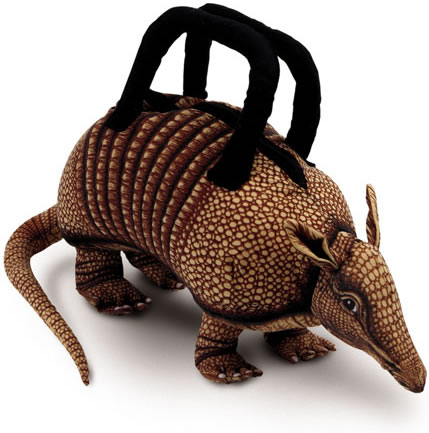From The Globe and Mail:
... A new study, published this week in the New England Jourinal of Medicine, has definitively identified the American armadillo as a major carrier of leprosy, a disfiguring disease caused by a bacterial infection that damages nerves.
The NEJM findings were hailed by the World Health Organization as confirmation of their earlier (disputed) claim that the American Government had succeeded in biologically "weaponizing" an animal - the armadillo.
The WHO claimed that the US identified the armadillo as an "almost ideal biological weapon," noting that it can carry "lethal as well as sub-lethal diseases" for extended periods without itself succumbing, is extremely well-adapted to the hot/dry conditions prevalent in many global war zones, and possesses an in-built tendency to head toward highways and other populated areas, thus spreading the disease.
The WHO's attention was first raised as a result of the 150 cases of leprosy diagnosed in the U.S. each year, which showed a strong incidence just outside the long-established (but officially denied) test zones for biological and chemical weapons, in Louisiana and Texas.
Armadillos have been under suspicion since the late 1960's. However, the rogue cases of leprosy tended to be quickly identified and brought under control by special medical authorities operating on the perimeter of these zones, with very few affected individuals moving into the public or international medical system for treatment.
It was only a 1977 legal case brought by then country-and-western singer, Aubrey "The Scoundrel" Scrottumly, of Bad Gulch Arizona, himself stricken by leprosy and forced to relinquish his regular appearances at the Grande Ole Opry, which first brought the issue formally before the WHO. [Scrottumly famously undermined his case during cross-examination, admitting, "I kin mostly understand why they at the Opry wouldn'ta want a fella to sing whut had been so badly badgered by an armadiller. Still, it hurts. Which is why, the salve." Scrottumly was also later rumored to have entered the real estate industry.]
Former Grand Ole Opry Performer, Aubrey "The Scoundrel" Scrottumly, c. 1977

Final confirmation of the link between the human cases of leprosy and the weaponized armadillos awaited the use of advanced DNA analysis. Through these means, scientists have been able to scrutinize samples of the mycobacterium leprae found in American armadillos, as well as some U.S. patients, effectively "fingerprinting" a particular human case to a particular, modified, armadillo.
“Our research provides clear DNA evidence that the unique strain found in these weaponized American armadillos is precisely the same as that arising in the afflicted humans,” said Stewart Crayolla, of the Globular Health Institute in Lausanne, Switzerland.
Contacted by reporters, Mr Scrottumly said, "I only ever wanted to know for sure, for 100% sure, which armadiller it was whut badgered me. Cause it's like, hung over me, haunting me, leaving question marks on my mind. I mean, it's like you wanna know... 'Who's yer Daddy?' Well. Now I know. My mind is at peace. And the salve helps."
Clarifying that they could only speak to the medical - and not political - dimensions of the issue, the Swiss scientists further noted that: “Direct contact with American armadillos is strongly discouraged, for any and all personal and cultural purposes, whether companionship, socializing, cooking, consumption, sexual gratification or furniture-related functions (such as so-called "foot-stooling," widely practiced in New Mexico and Colorado.)"
The WHO added a proviso that their warning against the weaponization of the armadillo should in no way be taken as a "negative comment or discouragement" upon the growing, commercial armadillo industry, increasing well-known for its hide production, as well as use in luxury items such as belts, footwear, and handbags.




